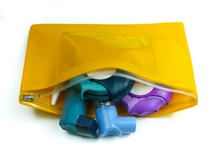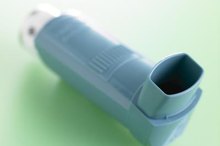List of Nebulizer Medications and Ingredients
As a chronic lung disease, asthma is commonly treated with inhaled medications delivered to the airways with either a handheld inhaler or a nebulizer. A nebulizer machine changes liquid medication into a mist inhaled through a mouthpiece or mask. In some some people, such as young children or older adults, a nebulizer is preferable to an inhaler because it requires little effort or manual dexterity. Nebulizer medications may be for quick relief or long-term asthma control, and work in different ways.
If you are experiencing serious medical symptoms, seek emergency treatment immediately.
Albuterol and Levalbuterol
Albuterol (AccuNeb) and levalbuterol (Xopenex) are closely related medications used for quick relief of asthma symptoms. Both can be delivered with a nebulizer. They act as bronchodilators, opening the airways that are constricted during an asthma attack.
Albuterol and levalbuterol relax the muscle cells of the airway walls, enabling better breathing.
Asthma management guidelines published in 2007 by the National Institutes of Health (NIH) recommend short-acting bronchodilators like albuterol and levalbuterol as first-choice treatment for asthma flareups in children and adults. They may be used alone or in combination with other drugs. Possible side effects of these medicines include temporary jitteriness and a racing heartbeat.
- Albuterol (AccuNeb) and levalbuterol (Xopenex) are closely related medications used for quick relief of asthma symptoms.
- Asthma management guidelines published in 2007 by the National Institutes of Health (NIH) recommend short-acting bronchodilators like albuterol and levalbuterol as first-choice treatment for asthma flareups in children and adults.
Ipratropium Bromide
List of Asthma Inhalers, Ingredients and How They Work
Learn More
Ipratropium bromide is another type of bronchodilator that can be delivered with a nebulizer for relief of asthma flareups. It works by decreasing constriction of the muscle cells of the lung airways, but acts differently than albuterol and levalbuterol. The 2007 NIH and 2015 Global Initiative for Asthma (GINA) treatment guidelines recommend use of ipratropium in combination with a short-acting drug like albuterol or levalbuterol for severe asthma attacks. A premixed combination of albuterol and ipratropium (DuoNeb) is available for nebulizer use.
Ipratropium is not recommended for use by itself for relief of sudden asthma symptoms. Possible side effects of ipratropium include dry mouth, dizziness and stomach upset.
- Ipratropium bromide is another type of bronchodilator that can be delivered with a nebulizer for relief of asthma flareups.
- A premixed combination of albuterol and ipratropium (DuoNeb) is available for nebulizer use.
Budesonide
Ongoing airway inflammation fuels the symptoms and complications of asthma.
Inhaled steroids reduce airway inflammation and the overall number of asthma flareups. **According to a September 2002 article in the journal "Annals of Internal Medicine," inhaled steroids reduce the number of inflammation-inducing cells in the lungs as well as suppressing inflammation in other ways 2.
** The 2007 NIH and 2015 GINA treatment guidelines recommend inhaled steroids as the first choice of medication for long-term asthma control. Budesonide (Pulmicort Respules) is the only inhaled steroid available for delivery using a nebulizer. Possible side effects include a hoarse voice and a yeast infection of the mouth called oral thrush.
- Ongoing airway inflammation fuels the symptoms and complications of asthma.
- According to a September 2002 article in the journal "Annals of Internal Medicine," inhaled steroids reduce the number of inflammation-inducing cells in the lungs as well as suppressing inflammation in other ways 2.
Cromolyn Sodium
Difference Between Nebulizer and Humidifier
Learn More
In asthma, interaction between an environmental trigger and the airways often provokes airway inflammation. Cromolyn sodium is an anti-inflammatory medication available for nebulizer use. According to a March 2005 study published in the "Journal of Asthma," cromolyn works by preventing both the activation and chemical release of inflammatory cells in the airways.
Cromolyn is used as a long-term asthma controller medication rather than a quick-acting reliever medication.
However, inhaled steroids are preferred and recommended over cromolyn because they are more effective. Possible side effects of cromolyn include coughing and throat irritation.
- In asthma, interaction between an environmental trigger and the airways often provokes airway inflammation.
- However, inhaled steroids are preferred and recommended over cromolyn because they are more effective.
Warning and Precautions
A nebulizer machine is a good option for some people with asthma, and may be easier to use during an asthma flareup. There are different kinds of nebulizers, and the medication you use influences the choice of nebulizer -- so discuss which nebulizer machine is best for you with your doctor. Asthma flareups can be sudden, so always keep the nebulizer clean and ready for use.
Asthma attacks can progress quickly and become life-threatening. Seek immediate medical attention if you experience sudden or worsening symptoms that do not respond to quick-relief treatment, including: - difficulty breathing - cough - shortness of breath - wheezing
- chest discomfort or tightness.
Medical advisor: Shilpi Agarwal, M.D.
- A nebulizer machine is a good option for some people with asthma, and may be easier to use during an asthma flareup.
- Asthma flareups can be sudden, so always keep the nebulizer clean and ready for use.
Related Articles
References
- Allergy: Diagnosis and Treatment of Asthma in Childhood: A PRACTALL Consensus Report
- Annals of Internal Medicine: How Do Corticosteroids Work in Asthma?
- Chest: The Role of Anticholinergics in Acute Asthma Treatment
- Journal of Asthma: Cromolyn Sodium: Fitting an Old Friend into Current Asthma Treatment
- National Heart, Lung, and Blood Institute: Expert Panel Report 3: Guidelines for the Diagnosis and Management of Asthma: Medications
- Cochrane Database of Systematic Reviews: Inhaled Corticosteroids Versus Sodium Cromoglycate in Children and Adults with Asthma
- Centers for Disease Control and Prevention. Consumer Information. Asthma.
- Expert Panel Report 3 (EPR3): Guidelines for the Diagnosis and Management of Asthma.
- Franks TJ, Burton DL, Simpson MD. Patient medication knowledge and adherence to asthma pharmacotherapy: a pilot study in rural Australia. Ther Clin Risk Manag. 2005;1(1):33–38. doi:10.2147/tcrm.1.1.33.53598
- Vernon MK, Wiklund I, Bell JA, Dale P, Chapman KR. What do we know about asthma triggers? A review of the literature. J Asthma. 2012;49(10):991-8. doi:10.3109/02770903.2012.738268
- Jiménez-ruiz CA, Andreas S, Lewis KE, et al. Statement on smoking cessation in COPD and other pulmonary diseases and in smokers with comorbidities who find it difficult to quit. Eur Respir J. 2015;46(1):61-79. doi:10.1183/09031936.00092614
- Mastronarde JG. Is There a Relationship Between GERD and Asthma? Gastroenterol Hepatol (N Y). 2012;8(6):401-3.
- Dogra S, Kuk JL, Baker J, Jamnik V. Exercise is associated with improved asthma control in adults. Eur Respir J. 2011;37(2):318-23. doi:10.1183/09031936.00182209
- Barnes PJ. Inhaled Corticosteroids. Pharmaceuticals (Basel). 2010;3(3):514-540. doi:10.3390/ph3030514
- Beasley R, Martinez FD, Hackshaw A, Rabe KF, Sterk PJ, Djukanovic R. Safety of long-acting beta-agonists: urgent need to clear the air remains. Eur Respir J. 2009;33(1):3-5. doi:10.1183/09031936.00163408
- Gadde D, Creticos P, Beakes D, et al. Adverse Effects Associated with Leukotriene Antagonist Therapy. Journal of Allergy and Clinical Immunology. 2010;125(2). doi:10.1016/j.jaci.2009.12.266
- Sorkness CA, Schend VA. Monitoring for Side Effects from Treatment. Clinical Asthma. 2008:313-319. doi:10.1016/b978-032304289-5.10035-9
- Ramsahai JM, Wark PA. Appropriate use of oral corticosteroids for severe asthma. Med J Aust. 2018;209(S2):S18-S21. doi:10.5694/mja18.00134
- U.S. National Library of Medicine. Asthmanefrin. 2017.
- NIH National Center for Complementary and Integrative Health. Asthma: In Depth. Updated September 24, 2017.
- Freitas DA, Holloway EA, Bruno SS, Chaves GS, Fregonezi GA, Mendonça KP. Breathing exercises for adults with asthma. Cochrane Database Syst Rev. 2013;(10):CD001277. doi:10.1002/14651858.CD001277.pub3
- Wechsler ME, Kelley JM, Boyd IO, et al. Active albuterol or placebo, sham acupuncture, or no intervention in asthma. N Engl J Med. 2011;365(2):119-26. doi:10.1056/NEJMoa1103319
- Medici TC, Grebski E, Wu J, Hinz G, Wüthrich B. Acupuncture and bronchial asthma: a long-term randomized study of the effects of real versus sham acupuncture compared to controls in patients with bronchial asthma. J Altern Complement Med. 2002;8(6):737-50. doi:10.1089/10755530260511748
- National Center for Complementary and Integrative Health. Asthma: In Depth.
- Wechsler ME, Kelley JM, Boyd IOE, et al. Active Albuterol or Placebo, Sham Acupuncture, or No Intervention in Asthma. New England Journal of Medicine. 2011;365(2):119–126. doi:10.1056/NEJMoa1103319
- Wilhelm CP, Chipps BE. Bronchial Thermoplasty: A Review of the Evidence. Ann Allergy Asthma Immunol. 2016;116:92-98. doi:10.1016/j.anai.2015.11.002
- Centers for Disease Control and Prevention. Consumer Information. Asthma.
- Expert Panel Report 3 (EPR3): Guidelines for the Diagnosis and Management of Asthma.
Resources
Writer Bio
A board-certified physician in family medicine, Dr.Toyin Fapohunda-Adekola is a graduate of the University of Medicine & Dentistry of New Jersey.With experience as a health columnist for a women's magazine, Fapohunda-Adekola enjoys presenting intriguing medical knowledge in a demystifying manner. She strives to awaken the self advocate in us all.







